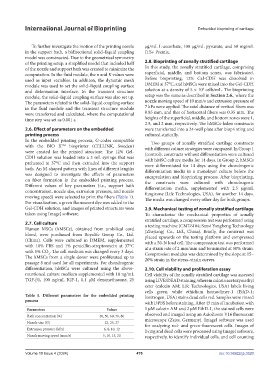Page 487 - IJB-10-4
P. 487
International Journal of Bioprinting Embedded bioprinting of cartilage
To further investigate the motion of the printing nozzle μg/mL L-ascorbate, 100 μg/mL pyruvate, and 50 mg/mL
in the support bath, a bidirectional solid–liquid coupling ITS+ Premix.
model was constructed. Due to the geometrical symmetry
of the printing setup, a simplified model that included half 2.8. Bioprinting of zonally stratified cartilage
of the nozzle and support bath was created to minimize the In this study, the zonally stratified cartilage, comprising
computation. In the fluid module, the n and K values were superficial, middle, and bottom zones, was fabricated.
used as input variables. In addition, the dynamic mesh Before bioprinting, 12% Gel-CDH was dissolved in
module was used to set the solid–liquid coupling surface DMEM at 37°C, and hMSCs were mixed into the Gel-CDH
6
and deformation interface. In the transient structure solution at a density of 5 × 10 cells/mL. The bioprinting
module, the solid–liquid coupling surface was also set up. setup was the same as described in Section 2.6., where the
The parameters related to the solid–liquid coupling surface nozzle moving speed of 10 mm/s and extrusion pressure of
in the fluid module and the transient structure module 7 kPa were applied. The axial distance of vertical fibers was
were transferred and calculated, where the computational 0.85 mm, and that of horizontal fibers was 0.35 mm. The
time step was set as 0.001 s. heights of the superficial, middle, and bottom zones were 1,
2.5, and 2 mm, respectively. The hMSCs-laden constructs
2.6. Effect of parameters on the embedded were transferred into a 24-well plate after bioprinting and
printing process cultured statically.
In the embedded printing process, G-codes compatible Two groups of zonally stratified cartilage constructs
with the BIO X bioprinter (CELLINK, Sweden) with different culture strategies were compared. In Group 1
TM
were created for the printed structure. The 12% Gel- (control), constructs without differentiation were cultured
CDH solution was loaded into a 3 mL syringe that was with hMSC culture media for 14 days. In Group 2, hMSCs
preheated at 37°C and then extruded into the support were differentiated for 14 days using the chondrogenic
bath. An M-shaped pattern with lines of different lengths differentiation media in a monolayer culture before the
was designed to investigate the effects of parameters encapsulation and bioprinting process. After bioprinting,
on fiber formation in the embedded printing process. the constructs were cultured with chondrogenic
Different values of key parameters (i.e., support bath differentiation media, supplemented with 2.5 µg/mL
concentration, nozzle size, extrusion pressure, and nozzle fungizone (Life Technologies, USA), for another 14 days.
moving speed) were selected to print the fibers (Table 1). The media was changed every other day for both groups.
For visualization, a green fluorescent dye was added to the
Gel-CDH solution, and images of printed structures were 2.9. Mechanical testing of zonally stratified cartilage
taken using ImageJ software. To characterize the mechanical properties of zonally
stratified cartilage, a compression test was performed using
2.7. Cell culture a testing machine (CMT6104; Sansi Yongheng Technology
Human MSCs (hMSCs), obtained from umbilical cord [Zhejiang] Co., Ltd., China). Briefly, the construct was
blood, were purchased from Boyalife Group Co., Ltd. placed upwards on the testing platform and compressed
(China). Cells were cultured in DMEM, supplemented with a 50-N load cell. The compression test was performed
with 10% FBS and 1% penicillin-streptomycin at 37°C at a strain rate of 2 mm/min and terminated at 50% strain.
with 5% CO . The cell medium was changed every 3 days. Compression modulus was determined by the slope at 15–
2
The hMSCs from a single donor were proliferated up to 20% strain in the stress–strain curves.
passage 8 and used for all experiments. For chondrogenic
differentiation, hMSCs were cultured using the above- 2.10. Cell viability and proliferation assay
mentioned culture medium supplemented with 10 ng/mL Cell viability of the zonally stratified cartilage was assessed
TGF-β1, 100 ng/mL IGF-1, 0.1 μM dexamethasone, 25 using LIVE/DEAD staining, wherein calcein acetoxymethyl
ester (calcein AM; Life Technologies, USA) labels living
cells green, while ethidium homodimer-1 (EthD-1;
Table 1. Different parameters for the embedded printing Invitrogen, USA) stains dead cells red. Samples were rinsed
process with DPBS before staining. After 45 min of incubation with
Parameters Values 1 μM calcein AM and 2 μM EthD-1, the stained cells were
Bath concentration (%) 40, 50, 60, 70, 80 observed and imaged using an AxioZoom V16 fluorescent
Nozzle size (G) 22, 25, 27 microscope (Zeiss, Germany). ImageJ software was used
for analyzing red- and green-fluorescent cells. Images of
Extrusion pressure (kPa) 6, 8, 10, 12 living and dead cells were processed using ImageJ software,
Nozzle moving speed (mm/s) 5, 10, 15, 20 respectively, to identify individual cells, and cell counting
Volume 10 Issue 4 (2024) 479 doi: 10.36922/ijb.3520

